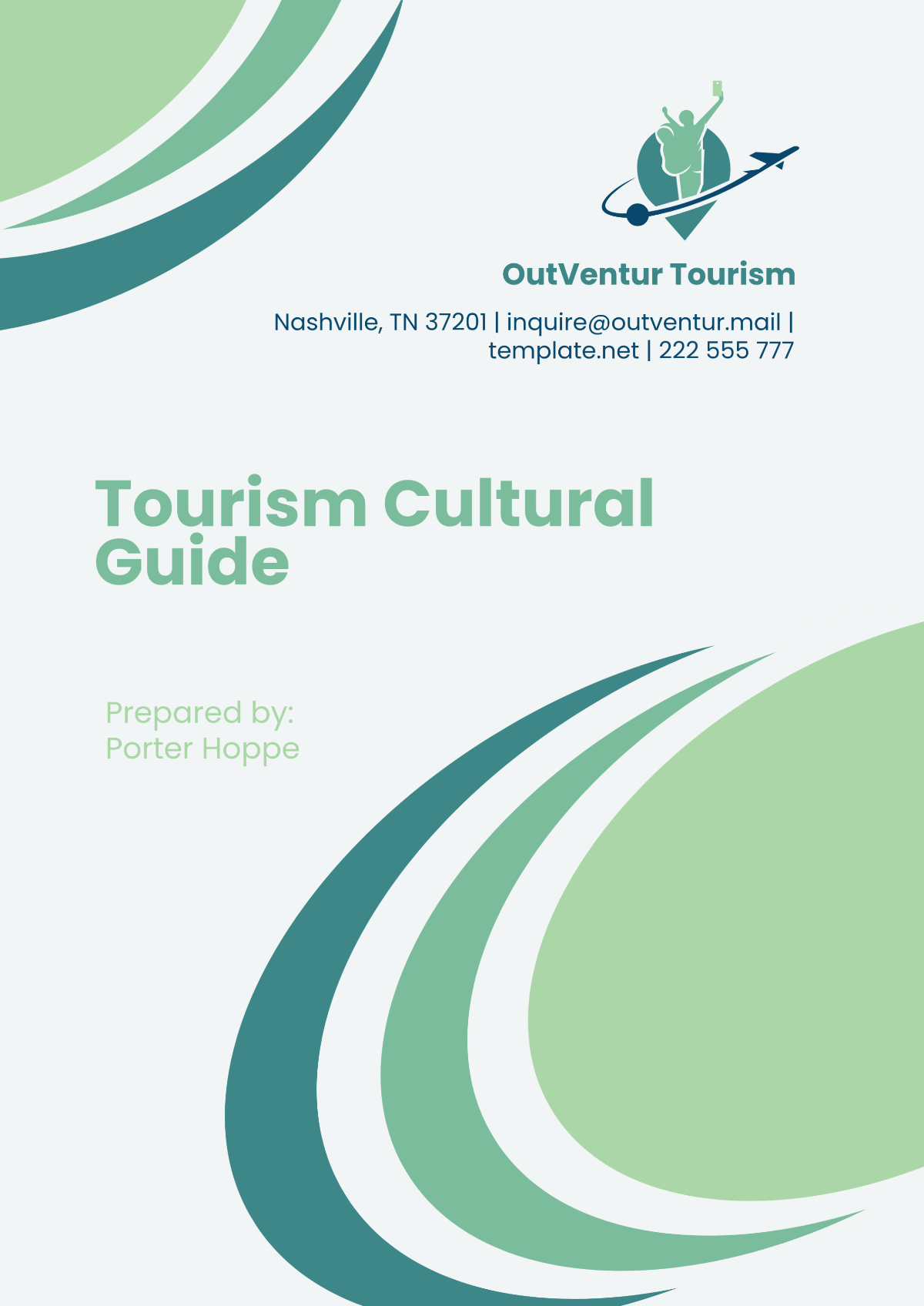Free Tourism Cultural Guide

1. Introduction to [Your Company Name]
[Your Company Name] is dedicated to offering an enriching and educational travel experience for those eager to explore the cultural heritage of the world. Since its founding in [Year], we have carefully curated itineraries that combine cultural exploration with deep educational value, aiming to connect travelers with the heart of a destination’s traditions, history, and lifestyle. Our goal is to foster a deeper understanding of the world by sharing the diverse cultural expressions that make each place unique.
Our expertise in the travel industry and commitment to excellence ensures that each journey is memorable, comfortable, and educational. With a strong focus on cultural immersion, we offer bespoke tours that allow travelers to experience the true essence of different cultures, whether through local culinary practices, traditional art, folklore, or architectural wonders.
[Your Company Name] believes in the importance of sustainable tourism, promoting respect for local communities and their heritage. We encourage responsible travel that minimizes the environmental impact while also contributing to the preservation of cultural landmarks and practices. Whether you are a history enthusiast, an art lover, or a foodie looking to explore new flavors, our diverse range of cultural tours will inspire and enlighten you.
2. The Importance of Cultural Tourism
Cultural tourism plays a significant role in shaping how societies interact with the world. In an age of globalization, where cultures can sometimes be diluted or forgotten, cultural tourism offers a platform for the preservation and celebration of traditions, arts, and customs. By learning about different cultures through travel, we gain not only enjoyment but also appreciation and respect for people from all walks of life.
2.1 Definition of Cultural Tourism
Cultural tourism is travel that emphasizes exploring the arts, history, heritage, and lifestyle of different communities. Unlike other forms of tourism that might focus primarily on natural landscapes or leisure activities, cultural tourism immerses travelers in the essence of a destination, providing them with the opportunity to engage with local populations and gain insights into their customs, rituals, and ways of life. This type of tourism is deeply rooted in the concept of experiential learning, where visitors don’t just observe but actively participate in the local culture.
Through cultural tourism, visitors are not only spectators but also participants in the stories and experiences of the places they visit. Whether it’s attending a local festival, visiting a historical landmark, or learning a traditional craft, cultural tourism offers a multifaceted understanding of a place.
2.2 Benefits of Cultural Tourism
The benefits of cultural tourism extend beyond just the travelers themselves. It is a win-win situation for local communities, economies, and the environment when approached responsibly.
Economic Growth: The influx of cultural tourists creates job opportunities and supports local businesses. Hotels, restaurants, souvenir shops, and tour guides all benefit from the visitors, thus directly contributing to the local economy. Additionally, cultural tourism often attracts high-spending visitors, such as those attending special exhibitions, festivals, or UNESCO World Heritage sites.
Cultural Exchange and Understanding: Cultural tourism encourages dialogue between different peoples, fostering an understanding of diverse customs and lifestyles. It helps break down prejudices and promotes peace by allowing people to appreciate shared humanity despite cultural differences.
Preservation of Heritage: Revenue generated from cultural tourism can directly contribute to the preservation of historical monuments, landmarks, and intangible cultural heritage. This includes restoring ancient buildings, supporting artisans who practice traditional crafts, and maintaining indigenous rituals and festivals. By investing in these practices, tourism helps ensure they continue for generations.
Educational Value: Traveling with a cultural lens allows people to gain a deeper knowledge of history, art, architecture, and sociology. It enriches travelers’ lives by broadening their worldview and offering new perspectives, often fostering lifelong learning and appreciation of the world’s diverse cultures.
2.3 Future of Cultural Tourism
As we approach the year [2050], the role of cultural tourism will continue to evolve. Increasing global awareness of environmental concerns and the importance of preserving cultural heritage will likely shape future trends in the industry. New technologies such as virtual reality (VR) and augmented reality (AR) will provide innovative ways to experience cultural sites and events, making them more accessible to those who cannot travel. Additionally, the rise of eco-tourism and responsible travel practices will push for even greater sustainability within the cultural tourism sector.
Global connectivity and social media will play a major role in shaping how cultural experiences are shared and marketed, enabling travelers to engage with local cultures before they even arrive. The importance of ethical and sustainable travel will grow, and with it, an increased responsibility for tourism companies to promote local culture with respect and integrity.
3. Key Elements of Cultural Tourism
Several key elements define cultural tourism, making it distinct from other types of travel. These elements are what make cultural tourism a truly immersive and transformative experience.
3.1 Art and Architecture
Art and architecture are the windows through which we can understand a culture’s soul. They reflect the ingenuity, spiritual beliefs, and social priorities of past and present generations. The iconic works of art found in museums and galleries, as well as the architectural wonders in cities and villages, tell the stories of civilization in a way that few other things can.
Whether it's the magnificent palaces of Spain, the intricate mosaics of Byzantium, or the medieval castles of France, architecture is a living testament to human creativity and adaptability. Similarly, the works of art displayed in major museums, such as the Louvre in Paris or the Museo del Prado in Madrid, capture the aesthetic ideals and emotions of the artists who created them.
Element | Description |
|---|---|
Art Galleries | Explore collections of world-famous art, paintings, sculptures, and photography from different eras and regions. |
Historic Buildings | Discover palaces, temples, churches, and monuments that showcase a nation's past and its architectural brilliance. |
Architecture | Admire distinct architectural styles and innovations that define the aesthetics of different cultures. |
3.2 Traditions and Festivals
One of the best ways to experience a culture is through its traditions and festivals. These events are often deeply rooted in history and are celebrated with music, dance, costumes, and rituals that connect the community to its past. From major religious festivals such as Christmas and Ramadan to unique local celebrations like the Day of the Dead in Mexico or the Songkran Festival in Thailand, cultural festivals are vivid expressions of identity and continuity.
By attending these festivals, travelers gain an understanding of how different cultures celebrate life, faith, and seasonal transitions, and they can participate in activities that may have been passed down through generations. These festivals provide the perfect opportunity for cultural exchange, as visitors interact with local residents and learn firsthand about the meaning behind the celebrations.
Festival | Country | Significance |
|---|---|---|
Carnival | Brazil | Marks the start of Lent with lively parades, music, and dancing, reflecting Brazilian cultural exuberance. |
Diwali | India | Celebrates the triumph of light over darkness, where streets are illuminated with lamps, and families gather for prayers and feasts. |
Oktoberfest | Germany | A large festival that celebrates Bavarian culture, focusing on beer, traditional foods, and folk music. |
3.3 Culinary Heritage
Food is one of the richest ways to connect with a culture, as it is directly tied to the land, traditions, and history of a people. Cultural tourism allows travelers to explore regional flavors, cooking methods, and local ingredients, which are often passed down through generations. Food tours, cooking classes, and market visits provide firsthand knowledge of a region's culinary practices and local specialties.
For example, in Italy, tourists can participate in a hands-on cooking class to make fresh pasta, while in Thailand, visitors might tour a bustling local market before learning how to prepare traditional Thai dishes. These experiences not only teach cooking skills but also provide cultural context behind each dish.
Dish | Country | Description |
|---|---|---|
Sushi | Japan | A dish made from vinegared rice paired with a variety of raw fish, vegetables, and sometimes tropical fruits. |
Pizza | Italy | A dish made of round dough topped with tomato sauce, cheese, and an array of toppings, which is then baked to perfection. |
Tacos | Mexico | A tortilla filled with a wide variety of ingredients, such as meats, beans, and salsa, typically folded into a hand-held snack. |
3.4 Historical Sites and Monuments
Exploring historical sites provides an invaluable connection to the past. Monuments, ruins, and ancient buildings are the remnants of past civilizations that offer deep insights into the values, practices, and achievements of our ancestors. Many of these sites, such as the Colosseum in Rome, the Great Wall of China, and the Pyramids of Egypt, are considered landmarks of human achievement and are often considered the cultural heritage of all humanity.
In addition to these grand structures, smaller historical sites such as local museums, ancient villages, or sacred shrines help piece together the puzzle of a region’s history. Travelers who visit these sites often leave with a profound sense of the continuity of human culture and a greater understanding of how civilizations have evolved over time.
3.5 Language and Communication
Language is a vital component of any culture. It’s not just a means of communication but also a way of expressing shared identity and values. Traveling in a foreign country provides an opportunity to learn new words, phrases, and dialects that are often deeply embedded in the cultural context of a place. While learning a language is a challenging process, even a basic understanding can significantly enhance a traveler’s experience, fostering deeper connections with local people and increasing cultural awareness.
Moreover, engaging in conversations in the local language helps break down barriers and enriches the travel experience. It also makes travelers feel more integrated and less like outsiders, increasing the likelihood that they will have meaningful interactions with locals.
3.6 Music and Dance
Cultural tourism often involves the discovery of a destination’s music and dance traditions. Music is the soundtrack of culture, and dance embodies the spirit and energy of a people. Whether it’s the flamenco rhythms of Spain, the drumbeats of West Africa, or the delicate movements of a traditional Japanese tea ceremony, these forms of expression are critical to understanding a culture’s social dynamics, beliefs, and history.
Participating in local music and dance traditions provides travelers with a hands-on, immersive experience. Many cultural tours offer the chance to learn traditional dances, participate in drumming workshops, or attend performances that showcase the rich musical heritage of the region.
4. Sustainable Cultural Tourism
With the rise in cultural tourism, it is important that both travelers and operators prioritize sustainable practices that ensure the long-term viability of cultural heritage sites and practices.
4.1 Responsible Travel Practices
Responsible cultural tourism involves being conscious of the impact tourism has on both the environment and local communities. Travelers should aim to respect local customs, traditions, and the environment. This includes using eco-friendly transportation, supporting local artisans, and minimizing waste.
To ensure responsible travel, it is also essential to make informed decisions when choosing a destination. Sustainable accommodations, which utilize local resources and employ environmentally-friendly practices, can significantly reduce the ecological footprint of tourism.
4.2 Community Involvement
Cultural tourism cannot succeed without the active involvement of local communities. It is essential that communities are given a voice in how tourism is developed and managed. Local guides, artisans, chefs, and performers often offer the most authentic experiences, and by supporting them, travelers contribute directly to preserving these cultures.
As cultural tourism continues to grow, partnerships between tourists, tour operators, and local communities will become increasingly important in ensuring the responsible management of cultural heritage and resources. By supporting initiatives that foster local empowerment, we help ensure that cultural tourism remains a positive force for both travelers and host communities.
5. Popular Cultural Tourism Destinations
[Your Company Name] provides a variety of travel packages that explore some of the most culturally rich destinations in the world. Below are just a few examples:
5.1 Europe
Italy: Italy is home to a variety of cultural treasures, from the Renaissance art in Florence to the classical ruins of Rome. Visitors can also indulge in Italian cuisine, visit ancient Roman sites, or attend opera performances.
France: With iconic landmarks such as the Eiffel Tower, the Palace of Versailles, and the artistic heritage of the Louvre, France offers rich cultural experiences. Additionally, the gastronomy of France, from croissants to wine, is world-renowned.
Greece: A hub for ancient history, Greece’s ruins, such as the Acropolis and Delphi, offer travelers a glimpse into the civilization that laid the foundation for much of Western culture.
5.2 Asia
Japan: Japan provides an intriguing blend of ancient traditions and cutting-edge modernity. Cultural tourists can explore ancient temples, such as those in Kyoto, or experience the technology-driven world of Tokyo.
India: India offers an incredible diversity of cultures, from the northern palaces of Rajasthan to the southern temples of Tamil Nadu. Historic sites, festivals, and vibrant street food offer an unparalleled cultural immersion.
5.3 Africa
Morocco: Known for its Arabic, Berber, and French influences, Morocco offers an array of cultural experiences, including visits to the imperial cities, ancient medinas, and desert oases.
Egypt: Egypt’s ancient monuments, including the pyramids, temples, and tombs, continue to captivate travelers from all over the world, providing a deep dive into the world of Pharaohs and the early civilizations of the Nile.
5.4 The Americas
Mexico: A rich tapestry of indigenous traditions and colonial history, Mexico is a must-see for travelers interested in culture. Visitors can explore ancient ruins such as Teotihuacan or enjoy the vibrant celebrations during Día de los Muertos.
Brazil: Brazil's festivals, music, dance, and natural beauty make it a destination that appeals to travelers from all over the world. With the world-famous Carnival and UNESCO World Heritage sites like Ouro Preto, Brazil offers diverse cultural experiences.
6. Conclusion
Cultural tourism offers an enriching way to travel and connect with the diverse cultures of the world. At [Your Company Name], we believe that every journey is an opportunity to learn, grow, and connect with the rich traditions that shape our world. Through cultural tourism, we invite travelers to gain new perspectives, broaden their understanding, and deepen their appreciation of the people, history, and arts that define the global tapestry of culture.
By promoting responsible, sustainable tourism, we can ensure that the cultural experiences we enjoy today will be preserved and accessible for generations to come. Join us in discovering the world’s heritage, and let each trip become an unforgettable story of cultural exchange and mutual respect.
- 100% Customizable, free editor
- Access 1 Million+ Templates, photo’s & graphics
- Download or share as a template
- Click and replace photos, graphics, text, backgrounds
- Resize, crop, AI write & more
- Access advanced editor
Share local culture and heritage with travelers using the Tourism Cultural Guide Template from Template.net. This editable and customizable guide provides valuable information about the culture, traditions, and customs of various destinations. Tailor it to specific locations using the AI Editor Tool.





























